The development of ventricular assist devices over the past 30 years

A large gap exists between the needs of patients with end-stage heart failure and the number of gold-standard heart transplants. Over the past 30 years, a revolutionary treatment strategy using ventricular assist devices (VADs) has rapidly developed and become widely used in clinical practice. However, few analyses have assessed the application and publication trends in the VAD field.
In a study published in Cardiovascular Innovations and Applications researchers used the Web of Science core collection to identify VAD research published between 1992 and 2022. Analysis and data visualization was performed with CiteSpace, Scimago Graphica, and VOSviewer.
A total of 13,274 articles published in 1,129 journals were identified, describing work from 6,351 institutions in 86 countries. Among them, the United States contributed the most to VAD research, and almost all the top 10 authors and institutions contributing to VAD research were from the United States.
In the past five years, VAD research has focused on right heart failure, outcomes, effects and risk factors, societies of surgeons, and clinical guidelines. Because of the large number of patients with heart failure, it is expected that VAD development to peak in the next decade.
More information:
Zhou Liu et al, The Development of Ventricular Assist Devices over the Past 30 Years: A Bibliometric Analysis, Cardiovascular Innovations and Applications (2024). DOI: 10.15212/CVIA.2023.0088
Provided by Compuscript Ltd